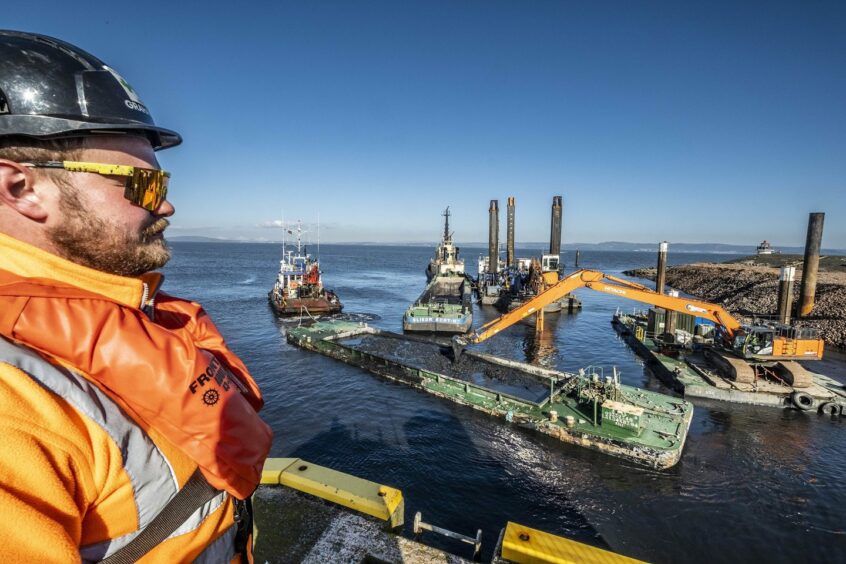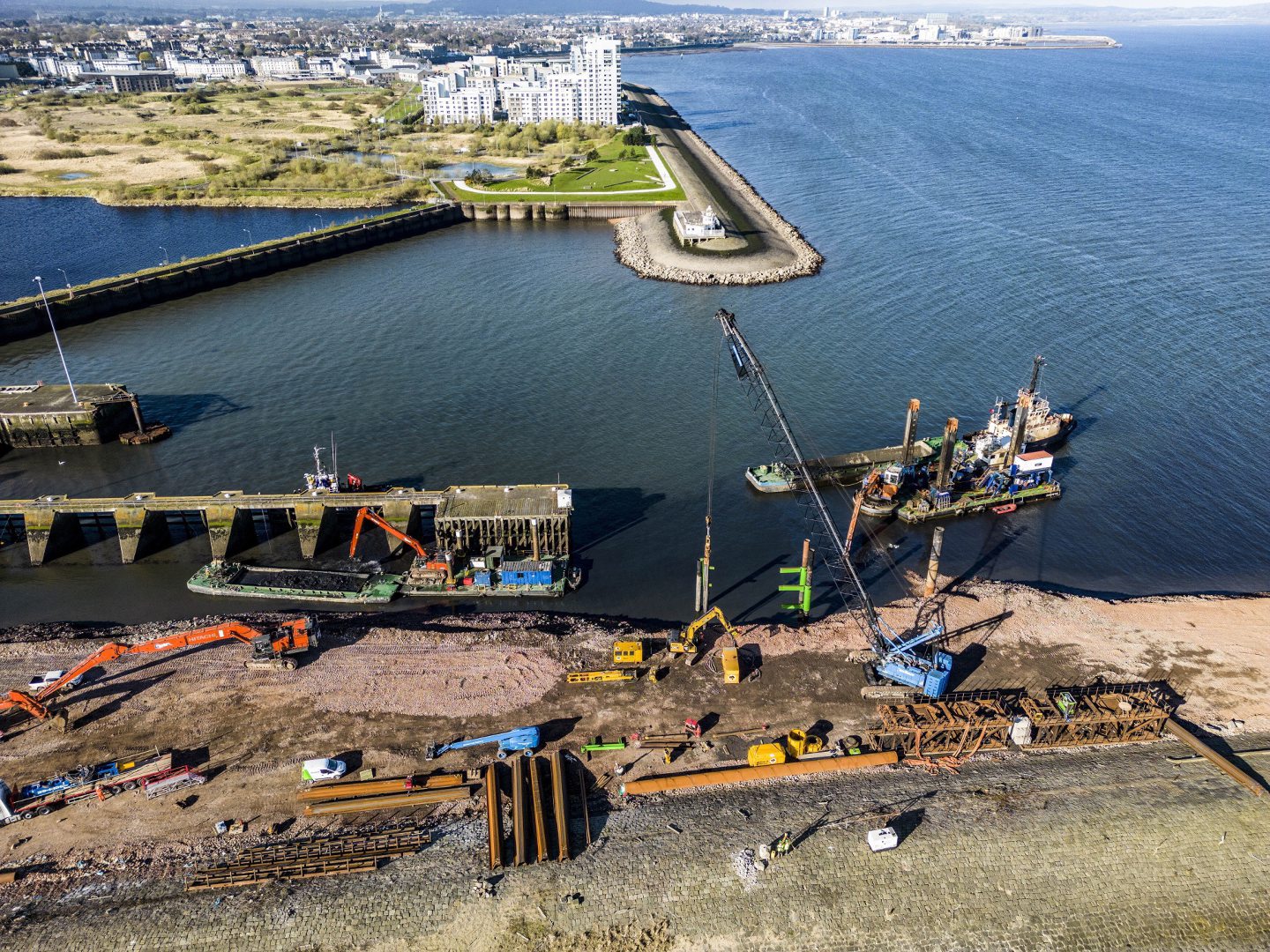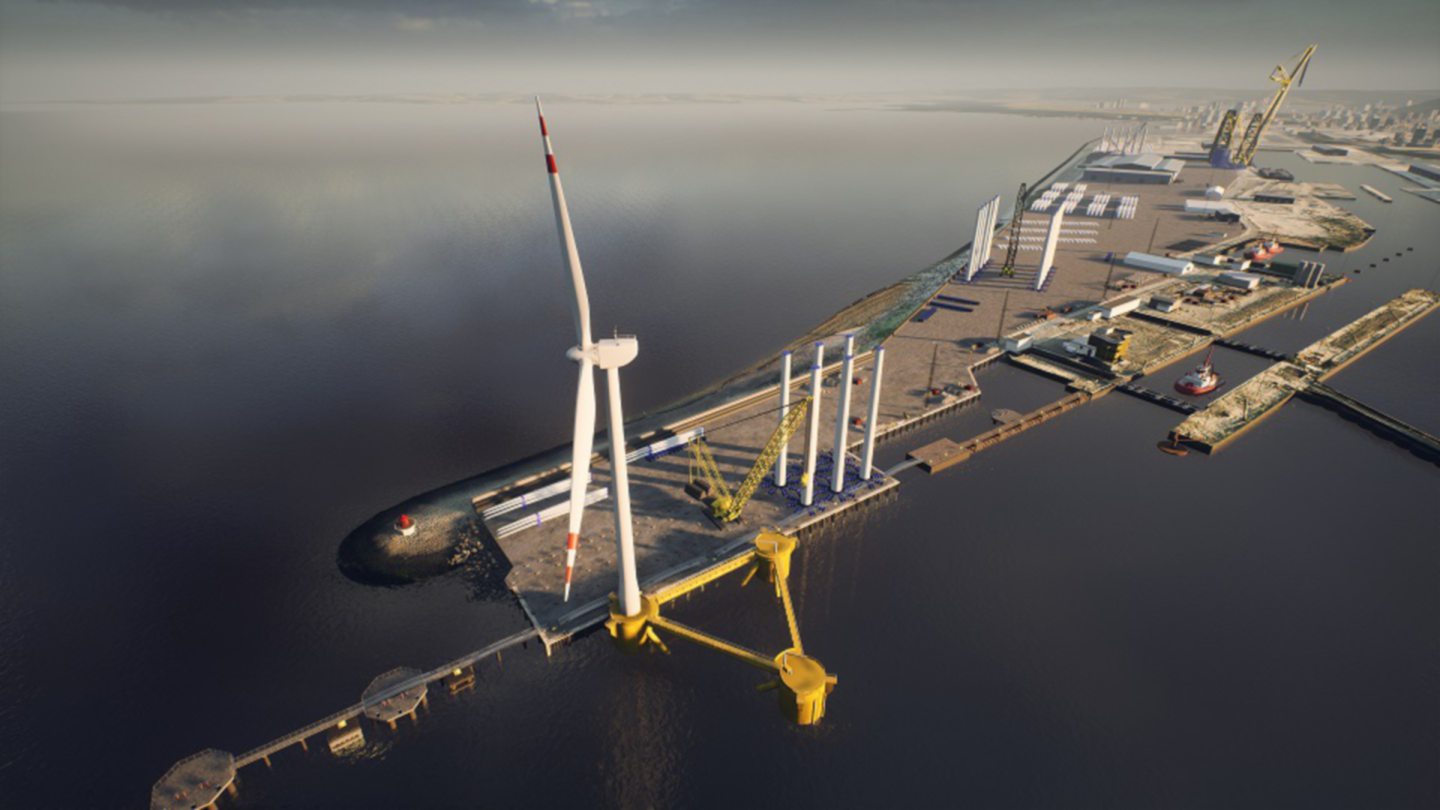
With construction works at Leith now well underway, bosses at Forth Ports say they will soon be ready for a tidal wave of work at Scotland’s newest wind marshalling site.
Despite it being well into June, it’s windy and chillier than expected on the several hundred metres of new quayside stretching its way into the Firth of Forth.
Part of a £50m investment, owner Forth Ports says the new outer berth at Leith in the north of Edinburgh will create “Scotland’s largest renewable energy hub”.
During Energy Voice’s visit, contractor Graham continued to carry out piling and construction, but the size and scope of the project is already evident. Stretching across a 175-acre site, the facility will soon be capable of accommodating the world’s largest offshore wind installation vessels.
New cranes, hundreds of metres tall, will add heavy lift capability of up to 100 tonnes per square metre, backed up by nearly more than 700 square metres of land for logistics, marshalling and manufacturing.
The berth lies outside the port’s lock gates, meaning vessels will not need to enter the locked port itself, all of which offers faster ship turnaround times and the freedom to accommodate larger vessels.
The development is further spurred by the award of green freeport status for much of the sites along the Firth earlier this year, and confirms the central belt’s role in the vast offshore energy build out set for the coming decades.
‘Multi-port’ strategy
Back in the (warmer) offices of the port operator, director of energy David Webster and chief financial officer Carol Cran explain the role of Leith in their plans. Asked about the significance of the facility relative to the opportunity presented by the boom in offshore wind construction, Mr Webster does not mince words.
“The challenge for Scotland was port infrastructure. I think we’ve solved that,” he says.
“These projects have very, very specific requirements: land space, deep water, heavy-duty quay sides, all that kind of stuff, plus the requirement for a supply chain behind it.
“The way we look at it, we’ve fixed the capacity challenge between Dundee and Leith in the scale of both ports – now we’re looking at building the supply chain both within our own organisation with Forth Projects, and wider as well.”
He says this “multi-port offering” allows the group to marshal foundations and turbines simultaneously between the two sites, bringing them together as they are needed in the construction phase for offshore projects.
A dedicated projects division, backed with a further £10m investment, will furnish those sites with an army of upskilled workers and dedicated plant to move those components around – already evident in Dundee, where work on the Neart na Goithe wind farm is well underway.
By investing in Leith – a site many times larger – ahead of the demand, Mr Webster hopes the bespoke facilities will cement the ports’ role in the transition.
“This market is very much driven is project driven and what we’re trying to do is turn this into a sustainable industry,” he explains.
“From our perspective, we have got a massive pipeline of projects; starting from right now we’re doing NNG in Dundee and from starting with that project up until 2040, we can see almost having constant activity going on in all our facilities – and that’s exactly what we want to achieve.”
Further work is locked in later this decade for BP and EnBW’s 2.9GW Morven wind project, the bid for which included a seven-figure investment in the port itself.
Green freeport impact
While Forth Ports has made commitments to Leith and Dundee that predate the government’s promise of green freeports – and the capital, tax and other incentives that come with it – their successful bid is nonetheless welcome news.
Encompassing a raft of Central Belt sites including ports at Rosyth and Burntisland, as well as Edinburgh Airport, backers have said the award would help secure up to £6bn of investment and 50,000 green jobs.
Opportunities along the Firth will span manufacturing, decommissioning, freight and more – though Ms Cran says “probably going to be Leith that leads the way” in terms of the immediate benefit to potential new customers.
As it stands the development is set to support up to 1,000 long term direct jobs and about 2,000 indirect jobs at Leith alone, with the potential for many more along the estuary.
“We’re not relying on the green freeport to make our business cases. However, it does mean that there’s greater opportunity, not just for the port, but the hinterland as well,” she explains.
Undoubtedly, there are still hurdles to overcome.
Consenting “needs to be streamlined” the executives agreed, both to enable construction and to send signals to the wider market that their investment is worthwhile.
“For us as port, investing ahead of the market is absolutely essential because by the time the developers ready to basically choose a facility, you don’t have time to build them,” adds Mr Webster.
“What causes issues with the supply chain is a lack of consistency of work,” he adds. “Making sure [ScotWind projects] all get consent would be helpful, and making sure there’s a grid connection – and I think the rest of the supply chain will fix itself if there’s a decent pipeline.”
And despite the healthy rivalry amongst port operators, the volume of work on the horizon means collaboration is just as important as competition. Mr Webster says Forth Ports is already working with Global Energy and its Nigg site in marshalling components for NnG, as well as a host of firms who’ve set up shop in Dundee.
“We talk to the other ports and then there are times where they run out of space and so we take some of the components and vice versa,” adds Ms Cran. “And I’m sure that will continue to be the case.”
Here for the long haul
There is plenty yet to accomplish at Leith – not least a new residential and commercial neighbourhood and a second phase of berth and laydown expansion. But will there be enough to work to sustain a wind-focused port beyond 2045?
“If you look at the timeline, every Scotwind project that was given a lease reckons have been done by 2030 – that’s not going to happen,” says Mr Webster.
“I reckon we’ll still be building windfarms in 2040-plus – and then there’s operations and maintenance, repowering, etc.”
Whether future plans would include exporting wind expertise, or a new as-yet undeveloped avenue in energy transition technology, Ms Cran said the leadership had not yet begun to contemplate that far ahead.
But Mr Webster reckoned the £50m spent now will help set the facility up for sustainable operations long into the future.
“This port’s been a port for hundreds and hundreds of years… They go through life cycles, and I don’t think you can ever really go wrong by building really good infrastructure and ports – especially when you’re near the biggest population centre in Scotland.”
Recommended for you

 © Supplied by Forth Ports
© Supplied by Forth Ports © Supplied by Forth Ports
© Supplied by Forth Ports © Supplied by Forth Ports
© Supplied by Forth Ports